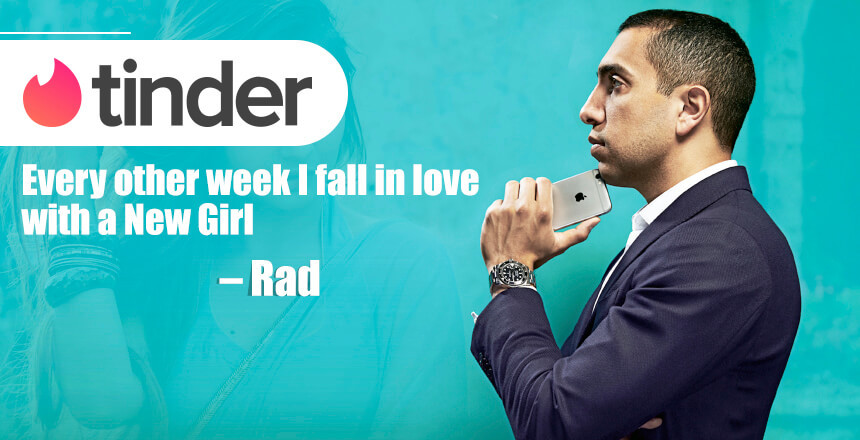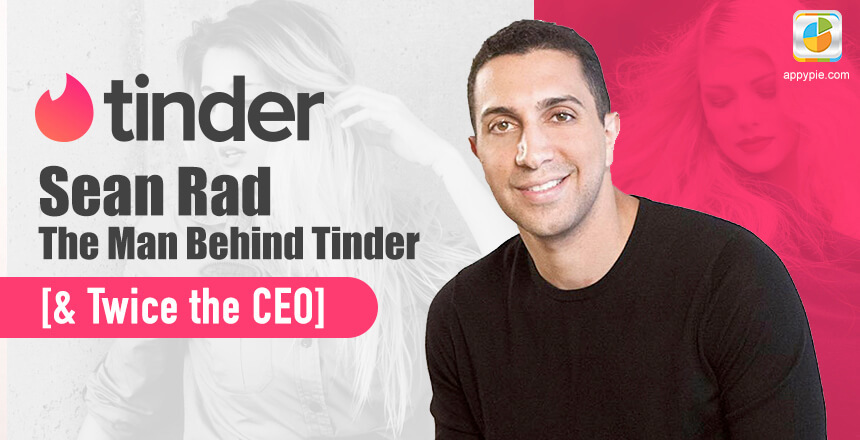Sean Rad The Man Behind Tinder [& Twice the CEO]

The man behind Tinder, the wildly popular dating app, Sean Rad has been having quite a turbulent run for some time now!
Tinder, when launched in 2012 was an instant hit and boasts to have made more than a million matches in less than two months. It gained the status of a phenomenon on the college campuses all across the nation and garnered attention & recognition among the tech bigwigs.
Today, after six years, the company is valued at around $3 billion and has become one of the top grossing apps in the App Store.
However, the journey of Sean Rad, the appreneur has been anything but a smooth sail! His journey with Tinder has been marked with scandals, surprise highs, and quite radical controversies.
One of the co-founders of the dating app, Whitney Wolfe had filed a sexual harassment lawsuit against another co-founder Justin Mateen who was also Rad’s college mate! Following this accusation, Rad had stepped down from his position as CEO, only to come back to it in a mere six months. Eventually after service twice as the CEO for Tinder, Rad stepped down for good and continued to serve as the chairman.
The latest in the line of controversies that seem to follow him around is his decision (along with 9 other ex and current employees of Tinder) to sue InterActiveCorp and Match Group (Tinder owners) for $2 billion.
Let’s talk first, about Tinder and what is it that made it such a big and instant hit! The app is almost synonymized with the iconic ‘Swipe Right’ and ‘Swipe Left’ gesture, but they didn’t really invent it. The gesture, in fact is a native aspect of the smartphone devices.
What actually happened is that Tinder took something as basic as a Swipe gesture and put it to a unique use and concept, thus giving it a cult-like status, so much so, that it was referenced all through the pop culture. Today this gesture as a concept is being emulated by a great number of apps.
On Tinder, when you Swipe Left or Right, you are letting the app know whether you like the person or not! This eliminates the need for you to select from one of the myriad options like accept, like, or anything else like Yes or No.
Now, let’s take a look at how Sean Rad caught a break and came up with Tinder, before helping it become the massive, billion-dollar startup that it became.
The Initial Years
Born in the mid-80s, Sean has his roots in Iran and his parents emigrated to US in the 70s. He grew up in a closely-knit Persian community in Beverly Hills and here, his parents made a successful career in the consumer electronics industry. At this point, Rad actually had absolutely no interest in anything related to the tech world. He in fact was inclined towards becoming a performer.

During a high school internship, he had a short stint in the world of music and entertainment but was quickly disillusioned with the innerworkings of the world of entertainment.
However, what really inducted him into the tech world is the cellphone that his parents gifted him when he was only 13. Though the intent of the gift was to cheer him up, but the tech bug got him instead. Though this was the pre-smartphone era and by the time iPhone hit the market Rad was already in his twenties.
5 years after he got his first mobile phone, Rad started is first tech company, right when he was starting at college. His company Orgoo, was supposed to be a unified commerce platform which was developed leveraging the mobile technology of the 2000s. This is where Rad also became friends with Justin Mateen who would later go on to co-found Tinder with Rad.
Though Orgoo didn’t really take off, Rad started Adly in 2006, that was designed to facilitate celebrity social media branding. To pursue his journey further in entrepreneurship, Rad soon dropped out of college.
Adly was a tad more successful than Orgoo and Rad was involved with it for a much longer time, before he got tired of bringing brands and celebrities together. This is when he sold his stakes in the company and moved on to join Hatch Labs which was a mobile app incubator based out of New York but had a branch out in Los Angeles as well.
While working on a loyalty app – Cardify, Rad along with Mateen was toying with the idea of building a flirting app based on the hot-or-not concept. In a hackathon held soon after by Hatch Labs, Rad joined hands with Joe Munoz to come up with something that they called Matchbox, at the time.
Matchbox won and Cardify took a backseat with the entire team shifting focus on to the future development of the hackathon winner.
It took three weeks of time and about $50,000 in investment to turn Matchbox into a polished version of the product which was ready for launch. Hatch Labs got some of its funding from IAC, who were the owners of the popular site Match.com, hence the app was rebranded as Tinder – a subtle derivation of the name Matchbox.

When the app was launched in 2012, the list of co-founders included Sean Rad, Justin Mateen, Jonathan Badeen, Joe Munoz, Whitney Wolfe, and Chris Gylczynski.
Mateen had a deep connect with a great number of college fraternities and sororities and knew how they ticked. He then chose to market the app by introducing it to the influencers at the elite schools.
It only took two months for Tinder to make more than a million matches and the app caught on like wildfire!
By early 2013, the app registered 400,000 users and pretty soon after that made a billion matches!
The gamification of the app’s user interface and the process of meeting new people was responsible for the quick popularity that Tinder enjoyed and by May 2013, it featured among the top 25 social networking apps.
The company dealt with a huge blow in 2014, when Whitney Wolfe Herd sued them for sexual harassment, alleging that Justin Mateen, her then boyfriend had harassed her while working at Tinder.
Following this debacle, Mateen left Tinder and Rad stepped down for the first time from his position of CEO but continued working with the company. In spite of this upheaval, the two still remained friends.
Chris Payne assumed the role of CEO for Tinder in the absence of Rad, but his tenure was short lived, and Rad was back as CEO within six months.
In 2015, once again Rad made headlines for controversial reasons as he gave quite an explicit interview pertaining to his sex life.

In December 2016, yet again he stepped down from the position of CEO, and this time, it was for good. However, he exchanged places with Greg Blatt and assumed Chairmanship giving the title of CEO to Blatt.
In 2017, Tinder was valued to stand at $3 billion!
One of the highest grossing apps in Apple Store, Tinder claims to have an 81% year on year growth in subscribers and is expected to exceed $800 million in revenue in 2018.
It was only this year in January, Elie Seidman became the CEO of Tinder.
In one of the most recent developments, in August 2018, 10 of the current and previous employees came together to file a lawsuit against IAC. In this lawsuit they claim that IAC used a lowballed valuation which was based on false information and thus lowered the value of stock options held by the early employees and the founders.
Through this lawsuit, Rad and other plaintiffs are seeking $2 billion from IAC.
The app and the company have always been in the limelight, sometimes for great reasons and at other times for scandals. One thing though that can be said about the app and about Sean Rad is that they are certainly not without some drama!
Related Articles
- Object-Oriented Programming (OOP) in Swift
- Best Sample Thank You Emails After An Interview
- An Introduction to Cross-Platform Mobile Apps
- Writesonic vs. Jasper: Workflow Automation and Integrations in AI Writing Tools
- How to Trademark your Logo in 2023 and why is it Important?
- 6 Small Businesses that can Benefit from Mobile Apps
- The Lavender Color: A Comprehensive Guide to its Shades, Tones, and Variations
- How to Create a Budgeting App? [+5 Best Budgeting Apps for 2021]
- For Loops in Swift (How To)
- Which Are the Top 10 Applications to Integrate With Klaviyo?
Most Popular Posts
- How to Create an Android App [A Guide to Creating Android Apps in 2024]
By Deepak Joshi | December 21, 2023
- How To: Pass Data Between View Controllers in Swift
By Abhinav Girdhar | October 19, 2023
 How to Download Music From Spotify?
How to Download Music From Spotify? By Samarpit Nasa | October 18, 2023
 Instagram Hashtags – A Complete Guide with Ideas
Instagram Hashtags – A Complete Guide with Ideas By Aasif Khan | October 17, 2023
 How to Watch the Star Wars Movies in Order: A Journey through the Galaxy Far, Far Away
How to Watch the Star Wars Movies in Order: A Journey through the Galaxy Far, Far Away By Samarpit Nasa | October 16, 2023

